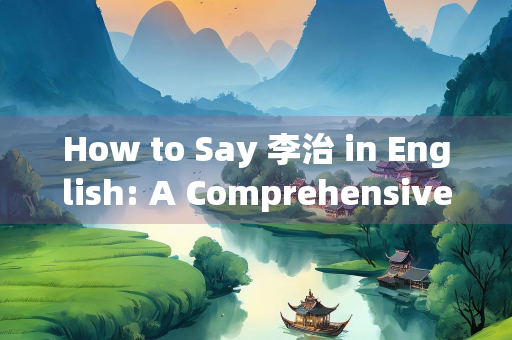Introduction

When it comes to translating Chinese names into English, there are mu lt iple approaches depending on context, pronunciation, and historical significance. One such name is"李治" (Lǐ Zhì), which can refer to different indiv id uals, most notablyEmperor Gaozong of Tang (唐高宗), a prominent ruler of the Tang Dynasty. This article explores the various ways to translate "李治" into English, its historical background, and the importance of accurate name transliteration.
1. Translating "李治" into English
1.1 Pinyin: The Standard Romanization
The most straightforward way to express "李治" in English is throughHanyu Pinyin, the official romanization system for Mandarin Chinese. In Pinyin, "李治" is written as"Li Zhi".
"Li" (李) is the surname, one of the most common Chinese family names.
"Zhi" (治) is the given name, meaning "to govern" or "to rule."
Thus, in modern contexts, "李治" is typically rendered asLi Zhi in English.
1.2 Wade-Giles and Other Romanization Systems
Before Pinyin became standard, older romanization systems likeWade-Giles were used. In Wade-Giles, "李治" would be written as"Li Chih".
"Li" remains the same, but"Zhi" becomes"Chih" due to differences in phonetic representation.
While Wade-Giles is less common today, some historical texts or older academic works may still use this form.
1.3 Cantonese and Other Dialectal Variations
In Cantonese, "李治" is pronounced as"Lei5 Zi6" (Jyutping romanization). Thus, in Hong Kong or among Cantonese speakers, the name might appear as"Lee Chi" or"Lei Ji" in English.
Other Chinese dialects may also influence how "李治" is romanized, but"Li Zhi" remains the most widely recognized form in international contexts.
2. Historical Context: Emperor Gaozong of Tang (Li Zhi)
2.1 Who Was Li Zhi?
"李治" is most famously associated withEmperor Gaozong of Tang (唐高宗, 628–683 AD), the third emperor of the Tang Dynasty. He ruled from 649 to 683 and was the son of the legendaryEmperor Taizong (李世民, Li Shimin).
Reign: Under his rule, the Tang Dynasty expanded its territory, and cultural achievements flourished.
Marriage to Wu Zetian: He marriedWu Zetian (武则天), who later became China’s only female emperor.
Legacy: Despite suffering from illness later in life, his reign was a period of stability and prosperity.
2.2 How Is Emperor Gaozong Referred to in English?
In historical and academic texts, "李治" as Emperor Gaozong is referred to in several ways:
1、"Emperor Gaozong of Tang" – The most formal and widely recognized title.
2、"Li Zhi, Emperor Gaozong" – Combining his personal name with his imperial title.
3、"Tang Gaozong" – A shortened version used in historical discussions.
Thus, when discussing the emperor, the correct English reference is"Emperor Gaozong" rather than just "Li Zhi."
3. Other Notable Figures Named "李治"
While Emperor Gaozong is the most famous, "李治" can refer to other individuals:
3.1 Modern Figures
Li Zhi (李治), a contemporary Chinese scholar or artist – In such cases, the name remains"Li Zhi" unless the individual adopts an English name.
Li Zhi (李志), a Chinese folk singer – Some Chinese musicians romanize their names differently, but "Li Zhi" is still standard.
3.2 Fictional Characters
In novels, films, or TV dramas, "李治" may appear as a character. Translators might:
- Keep it as"Li Zhi" (direct Pinyin).
- Use"Lee Chi" (alternative romanization).
- Assign an English name (e.g., "Leo Li") for accessibility.
4. The Importance of Accurate Name Translation
4.1 Preserving Cultural Identity
Names carry cultural significance, and proper romanization ensures respect for Chinese heritage. Mispronunciations or incorrect spellings can lead to misunderstandings.
4.2 Academic and Historical Accuracy
When discussing historical figures like Emperor Gaozong, using the correct title ("Emperor Gaozong of Tang") is crucial for scholarly precision.
4.3 Practical Considerations in Global Communication
Passports & amp ; Official Documents: Chinese citizens use Pinyin ("Li Zhi") in legal contexts.
Media & Entertainment: Some celebrities modify their names for international appeal (e.g., "Jet Li" instead of "Li Lianjie").
5. Common Mistakes in Translating "李治"
5.1 Misromanization
- Writing "李治" as"Lee Zhi" (mixing Wade-Giles and Pinyin).
- Incorrectly spelling it as"Li Chi" (confusing Pinyin with other systems).
5.2 Confusing with Similar Names
Li Si (李斯): A Qin Dynasty chancellor.
Li Bai (李白): A famous Tang Dynasty poet.
5.3 Over-Anglicization
Some may attempt to "Westernize" the name (e.g., "Richard Li"), but this is unnecessary unless the individual prefers it.
6. Conclusion: How to Correctly Say "李治" in English
To summarize:
Standard Pinyin:Li Zhi (for modern individuals).
Historical Figure:Emperor Gaozong of Tang (for the Tang Dynasty ruler).
Alternative Romanizations:Li Chih (Wade-Giles),Lee Chi (Cantonese-influenced).
Understanding the context is key—whether discussing history, modern figures, or fictional characters. Proper name translation bridges cultures and ensures accurate communication.
Would you like further details on any specific aspect of "李治" in English? Feel free to ask!
本文地址: https://www.shuiwy.com/a/99580.html
文章来源:im
版权声明:除非特别标注,否则均为本站原创文章,转载时请以链接形式注明文章出处。
2025-12-11im
2025-12-11im
2025-12-11im
2025-12-11im
2025-12-11im
2025-12-11im
2025-12-11im
2025-12-11im
2025-12-11im
2025-12-11im
2024-03-03im
2024-01-24im
2023-05-29im
2023-06-04im
2023-06-16im
2023-10-07im
2023-06-20im
2023-10-07im
2023-06-19im
2023-06-14im
2025-12-11im
2025-12-11im
2025-12-11im
2025-12-11im
2025-12-11im
2025-12-11im
2025-12-11im
2025-12-11im
2025-12-11im
2025-12-11im
扫码二维码
获取最新动态
